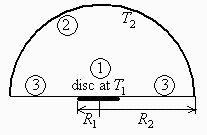| > | restart:#"m13_p28" |
Consider a hemispherical shell of 1 m in diameter, at 500 K, a circular disc of 0.1 m in diameter, concentric, in the base plane and at 300 K, and the circular corona at the base that completes the closure of the hemisphere, also at 500 K. Assume that there is only heat transfer by radiation (no convection and no conduction through the contacts). Find the heat transfer received by the disc in the following cases:
a) Assuming that all surfaces are black-bodies.
b) Assuming that all surfaces are grey-bodies with =0.8
Data:
| > | read`../therm_eq.m`:read`../therm_const.m`:read`../therm_proc.m`:with(therm_proc):with(RealDomain): |
| > | dat:=[R2=0.5*m_,T2=500*K_,R1=0.05*m_,T1=300*K_,T3=500*K_,epsilon=0.8]; |

Fig. 1. Disc radiatively heated by a hemispherical dome.
| > | dat:=op(dat),Const,SI2,SI1: |
a) Assuming that all surfaces are black-bodies.
In this case that there are no reflections, the disc only sees the dome, and we have :
| > | Q21:=A2*F21*sigma*(T2^4-T1^4); |
using the reciprocity relation A2F21=A1F12 simplifies the problem, since F12=1 because all the energy radiated by surface 1 falls on surface 2
| > | Q21:=A1*F12*sigma*(T2^4-T1^4);A1:=Pi*R1^2;F12:=1;Q21_:=subs(dat,evalf(subs(dat,Q21))); |
i.e. the disc 1 gets 24 W from the cupola. Notice that the heating of the disc does not depend on the temperature of the corona 3 (neither on its thermo-optical properties), if surface 2 is a black-body at a fixed temperature (but the state of 3 would have an influence on the energy balance of 2).
b) Assuming that all surfaces are grey-bodies with =0.8.
In this case we have a two-surface enclosure (the disc 1 of area D12/4, and the rest 2 plus 3 of area D22+D22D12)/4), with F1,2+3=1.
In the approximation A1<<A2, the heat that 1 gets from 2+3 (we label it '23') is:
| > | A23:=2*Pi*R2^2+Pi*(R2^2-R1^2);F[1,23]:=1;Q[23,1]:=Q[1,23];Q[1,23]:='A1*epsilon1*sigma*(T1^4-T2^4)';Q[1,23]:=evalf(subs(epsilon1=epsilon,epsilon2=epsilon,dat,%)); |
i.e. the disc receives 19 W from the rest (the hemisphere and the coplanar corona).
We can check the discrepancy with retaining the finite size of the enclosure:
| > | Q[1,23]:='A1*sigma*(T1^4-T2^4)/(1/epsilon1+(A1/A23)*(1/epsilon2-1))';Q[1,23]:=evalf(subs(epsilon1=epsilon,epsilon2=epsilon,dat,%)); |
 |
i.e. no worth the extra effort.
| > |